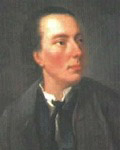|
Charles Avison (the portrait on the left is in the Laing Art Gallery, Newcastle) was born in Newcastle upon Tyne and died there aged sixty, he was the only English born Concerto Grosso composer. He was a pupil of the violinist and composer Francesco Geminiani (himself a pupil of Corelli) in London.
Being the fifth child of nine born to Richard and Ann Avison, Charles' musical education probably began at home under his father who was a Town Wait employed by the council.
In 1735 Geminiani offered Avison two posts of Organist in Dublin, but he turned them down in the June of 1736 in favour of the position of organist at St. John's Church in Newcastle.
He was also appointed organist St. Nicholas' Cathedral in Newcastle at a salary of £20 a year, upon the the death of Thomas Powell in the October of 1736.
Avison married Catherine Reynolds on the 15th January 1737, they had three children that survived into adulthood Jane, Edward and Charles. Both Edward and Charles later became organists at St. Nicholas' Cathedral in Newcastle.
In his private rooms in Rosemary Lane, Newcastle he taught the flute, violin and harpsichord. One pupil taking violin lessons was an apprentice boat builder called William Shield from Whickham, he later became the leader of the orchestra formed to give Avison's subscripton concerts in Newcastle.
This series of subscription concerts started in 1735 were given in the Assembly Rooms and the Long Room in the Turk's Head, Newcastle, where works by Corelli, Handel, his friend Geminiani and himself were performed. In July 1738 Avison was appointed musical director of the Newcastle Musical Society, a post that he held until his death. Until the performances given by the Avison Ensemble, the last known public performance of Avison's work took place in 1822.
 Charles Avison was a most prolific composer and published over eighty concertos, many sonatas including twelve arrangments of sonatas by Domenico Scarlatti. For details of a set of six concertos see the article on his music. Charles Avison was a most prolific composer and published over eighty concertos, many sonatas including twelve arrangments of sonatas by Domenico Scarlatti. For details of a set of six concertos see the article on his music.
A famous Essay on Musical Expression published in 1752 provoked much discussion and had many public replies, because of its frank treatment of the works of Handel and others.
Dr. Charles Burney, famous for his History of Music in four volumes, wrote after Avison's death that he was "An ingenious and polished man, esteemed and respected by all who knew him; and an elegant writer upon his art." and names him as the first person to attempt an article on the criticism of music.
Apart from a brief revival a century after his death, of a "Grand March" of his for harpsichord in Browning's "Parleyings with certain people of Importance in their Day", his music is largely forgotten.
He is buried under the gravestone shown above near to the entrance of St. Andrew's Church, Gallowgate, Newcastle upon Tyne.
|




 Charles Avison was a most prolific composer and published over eighty concertos, many sonatas including twelve arrangments of sonatas by Domenico Scarlatti. For details of a set of six concertos see the article on his music.
Charles Avison was a most prolific composer and published over eighty concertos, many sonatas including twelve arrangments of sonatas by Domenico Scarlatti. For details of a set of six concertos see the article on his music.